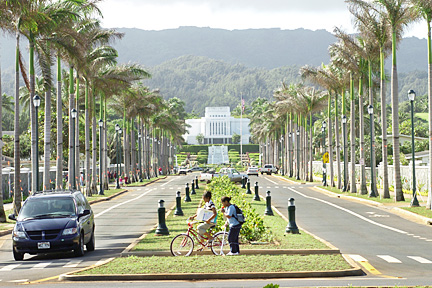
|
View from
the Pew |
Bordering on glory
Stone walls weigh down an
enlightening experience at
Laie’s Mormon temple
There's an old Spanish mission church in Arizona described as the "white dove of the desert." San Xavier del Bac can be seen for miles, a jewel among tan foothills and bright blue sky. No need for a sign to identify it as a statement of faith by the builders.(Don't tell me if it's been overshadowed by Tucson sprawl; I want to remember the sight.)
That's how I feel about a beacon of faith in the hills here at home, the Laie Temple of the Church of Jesus Christ of Latter-day Saints. The sign at Kamehameha Highway is redundant -- once anyone looks toward the hills, there's no doubt that this is a place special to those who built it. A classical white landmark at the top of exquisite landscaped terraces, it used to be on the stop-and-click agenda for anyone taking visitors around the island.
Not so many tour buses turn off Kamehameha Highway for the view these days. Nary a bus and only one car made the trek during my visit to the site Wednesday. Perhaps a lengthy construction period took it off the tour itineraries.
My theory is that the forbidding expanse of new walls turns people away. It certainly undermined the spectacular view. Shoulder-high gray stone topped with white concrete extends for four blocks along Hale Laa Boulevard. It overshadows any positive effect of landscaping put in place during the $6 million refurbishing completed in December.
The new rows of royal palms, replacing termite-eaten ironwoods, were enough. Instead of the temple appearing to float upward into green mountain and blue sky, it's anchored downward by walls, not even typically island moss rock walls. It's a gem overwhelmed by a heavy, fussy setting.
The architects/designers are of the same school as those who needed to announce the lush natural glory of Nuuanu Valley with a huge and heavy stone sign.
This ugliness wasn't a new revelation. My Sunday swimming gang goes into a "tsk tsk" mode each week as we do an exasperated "eyes right," and again with eyes left at the maze of wall and barricade that blocks the ocean front at the bottom of Hale Laa.
When I shared our criticism, a Mormon elder, who shall remain anonymous, agreed. He described the walled view plane as "looking down the gun barrel."

Rows of royal palms and new stone walls extend for four blocks along Hale Laa Boulevard, the road that leads to the Mormon temple in Laie.
The center reopened in January after a retrofitting. It's still a cool oasis stop for visitors, but it's gone from passive to active voice. It used to be a brief stroll through museumlike wall displays mostly about the Laie community (settled by Mormons in the 1860s) and the building, modeled on someone's idea of ancient South American temples, finished in 1919, the first Mormon temple outside the continental United States.
It's now a multimedia, interactive experience. Touch any of the arrays of buttons, and the video screen provides a sound bite of LDS beliefs, told by charming children. Asked what happens when you die, a little sprite recites, "Your spirit comes back to your body. It's going to be a perfect body."
In an exhibit on what God says about the family, visitors find benches at stops along a darkened corridor where stage scenes such as the baby nursery and grandpa's front door are the setting for video enactments, each driving home a point about teaching children righteousness, the family united even after death.
A conversational tactic of the missionary guides is to talk about the parts they like best. A young woman from Japan tells how her belief about her grandmother's death was cleared up when she joined the church. Guides with a variety of languages engage visitors from other countries.
So bland and soft is the message that some visitors might not hear anything that contradicts other beliefs, and there are several such threads in Mormon teaching.
A finale video about divine revelations to Joseph Smith, founder of the church, tells that "there are new prophets in every age" down to the present. It states that the Gospel of Jesus was revealed to Adam, Noah and other characters in the Old Testament.
The part I liked least was the assertion that Christ's "message was altered" before Smith came along, and "essential truths were lost" until he got Christianity back on track. But that's what Mormons believe and this is their show.
Elder Jay Geddes, director of the visitor center, said visitors do sometimes "challenge" or ask questions. "Most of the missionaries are capable of handling questions," he said. Sometimes someone, such as a Christian pastor, wants further debate, he said, and they are referred to senior elders such as himself.
Geddes said the center has about 11,000 visitors each month. Many of them are brought over in small trolleys as part of the Polynesian Cultural Center experience.
An estimated 35 percent of visitors are Latter-day Saints themselves. Like all churches, said Geddes, there are members who are not active and who might use this as a short refresher course.
"There are people who haven't read the Bible or the Book of Mormon," he said. "A lot of people have to bolster their education."
![]()
E-mail to Features Desk
[News] [Business] [Features] [Sports] [Editorial] [Do It Electric!]
[Classified Ads] [Search] [Subscribe] [Info] [Letter to Editor]
[Feedback]
